How to Backup Your MacBook: Top 7 App Reviews and Tips

Image: Generated with Dall-E
Data loss is a nightmare for everyone. Whether it’s due to system failure, accidental deletion, or even theft, the risks are real.
According to a study by Backblaze, 46% of people lose data each year, 50% of hard drives die within five years, and 15% of households experience theft annually.
Learning how to backup your MacBook is not a luxury but a necessity for safeguarding your professional data. Encrypting your backups is crucial, especially when dealing with sensitive information, as it ensures that even if someone gains access to your backup files, they can’t read the data without the encryption key.
A reliable backup solution helps you quickly recover from unexpected data loss, saving time and protecting sensitive information.
Below, you’ll find a complete overview of how to backup your MacBook with the best backup apps for Mac and why options like iCloud sync are NOT a backup solution.
Table of Contents
TOC
Why You Need a Backup Strategy for Your MacBook

Image: Fabian Irsara
Learning how to backup your MacBook is a crucial step in protecting your personal and business data against a range of risks.
Give Yourself Peace of Mind
Data loss can be stressful and disruptive, especially when it involves work files or personal information. A backup strategy for your Mac provides peace of mind, knowing that your important data is safe and always recoverable – even if you accidentally delete a file and join the 74% of Americans who have made the same mistake.
Spend Less Time Recovering Your Data
Time is a precious resource for every working professional. In the event of a system failure or data corruption, having a backup means you can quickly restore your files and get back to work with minimal downtime. The swift recovery process helps you maintain productivity and avoid spending hours or even days trying to recover your lost data if you can recover it at all.
Protect Your Sensitive Information
As a professional, you often handle sensitive client data, financial records, or personal documents. Losing such data risks your business reputation and exposes you to potential legal and financial liabilities. By implementing a secure backup strategy for your Mac that includes encryption, you can add an extra layer of security, safeguarding your business and data from unauthorized access.
Hardware Failures
MacBooks are not immune to hardware failures despite their reputation for quality and durability. Hard drives can fail, batteries can die, and physical damage from accidents can leave your MacBook nonfunctional. With Mac hard drives having an average lifespan of 3 to 5 years, you need to prepare for the day when it inevitably fails.
Mitigating Cyber Threats
Cybersecurity threats such as malware, ransomware, and hacking are ever-present dangers. Ransomware, in particular, can lock you out of your files, demanding payment for their release. Regularly backing up your MacBook ensures that you always have a clean copy of your data in case of a cyberattack.
How to Backup Your MacBook: What to Avoid

Image: Crew
While knowing how to backup your MacBook is crucial, some “methods” can leave you vulnerable to data loss and give a false sense of security.
Manual File Backup
Manually copying files to an external drive might seem like a good option for backing up your MacBook, but it’s far from the perfect solution.
While you do have complete control over your backups, and it requires no software:
- It’s prone to human and hard drive errors.
- It’s time-consuming.
- It lacks version history.
As a busy professional, the last thing you want to do is remember to connect an external hard drive and manually copy files. The lack of automation means spending less time on billable work, reducing profitability, and leaving your business at risk by accidentally overlooking important files.
iCloud Sync
iCloud is Apple’s cloud storage solution, automatically syncing files and photos across your devices. While iCloud can be convenient for accessing files from multiple devices, it’s important to understand that syncing is not the same as backing up your Mac.
iCloud synchronizes changes across devices, meaning if you accidentally delete a file on your MacBook, it will also be deleted from iCloud. You’re not creating snapshots of your data over time, making it more similar than different to Google Drive.
While Apple offers an iCloud backup, it’s different from iCloud Drive and is only available for backing up iOS devices, not Macs.
The Bottom Line: iCloud should be used as a supplementary tool for file access rather than a primary backup method. True backups ensure you can recover files in their original state, even if they are deleted or corrupted on your MacBook.
Cloud Storage Services: More Storage Than Backup
Services like Dropbox, Google Drive, and OneDrive are often mistaken for backup solutions. While they provide cloud-based storage and syncing capabilities, they fall short in providing the comprehensive protection you need from backup software for Mac.
Like iCloud, these services focus on syncing files across devices and facilitating collaboration rather than safeguarding data against loss or corruption. While some services offer a limited file versioning feature, it is not as extensive or reliable as the version history and recovery options provided by true Mac backup solutions.
That’s not all.
- There’s limited storage on free plans.
- You need to have an internet connection for automatic file syncing and access.
- Your data is stored on third-party servers, opening you up to privacy risks.
When considering how to backup your MacBook, it’s vital to recognize the limitations of manual file backups, iCloud syncing, and cloud storage services. These methods may give the illusion of data safety, but they fall short in critical areas like automation, versioning, and comprehensive recovery.
How to Backup Your MacBook: The Best Comprehensive Strategy
The easiest way to backup your Mac would be to use Apple’s built-in backup software, Time Machine. It’s free and only requires an external hard drive, making it an ideal choice for users who want a native, hassle-free backup solution.
However, it’s not the most comprehensive. It lacks offsite backup options, leaving your data vulnerable if the external drive is lost or damaged. Third-party apps provide more customization, security, and advanced features that you might prefer.
Below, you’ll find our roundup of the best backup software options for Mac and alternatives to Time Machine to help you create a solid backup strategy that balances ease of use, automation, and flexibility. (For a broader range of tools, check out our list of the best Mac apps to enhance your productivity.)
Before we dive into them in detail, here’s a high-level snapshot of what to expect from each one:
- Time Machine: A free and native Mac backup solution.
- Backblaze: An affordable, cloud-based backup app with unlimited storage.
- Carbon Copy Cloner: A powerful cloner for your macOS operating system, applications, and settings.
- SuperDuper: An easy-to-use and versatile backup solution.
- Arq: A secure cloud-based solution with multiple cloud storage options.
- Get Backup Pro: A feature-rich option offering high control over your data and usability.
- ChronoSync: A customizable backup app for syncing data between multiple devices.
The Best Backup Software for Mac Users
When it comes to finding a solution to the question “how to backup your MacBook”, there is no shortage of options. However, some solutions offer specialized features that make them particularly suited for different needs. Let’s take a closer look at the top-recommended options.
1. Time Machine

As mentioned above, Apple has its own built-in backup solution, Time Machine, offering a native and user-friendly way to safeguard your data and backup your MacBook.
However, the Mac backup software does more than create a single copy of your computer; it also offers versioned backups. This means it retains hourly backups for the past 24 hours, daily backups for the past month, and weekly backups for each prior month, allowing you to restore your Mac to a specific point in time or recover an earlier version of a document.
Pros:
- Easy to set up and use, even for beginners.
- Automatic and continuous backups without manual intervention.
- Integrated with macOS, offering seamless performance.
- Versioned backups allow you to recover specific files or previous versions of documents.
- Hourly, daily, and weekly backups provide multiple points of recovery.
- Allows full system restore, including applications and settings.
Cons:
- Requires an external hard drive.
- No offsite or cloud-based backup option, leaving data vulnerable to physical damage or theft.
- Backups can consume significant space on the external drive over time.
- Recovery speed can be slow, especially if backing up or restoring over Wi-Fi.
- Can’t schedule backups.
- Less secure than the cloud.
- Not a comprehensive disaster recovery solution if the external drive is stored in the same location as the Mac.
Rating: 4 out of 5
Pricing: Free
2. Backblaze
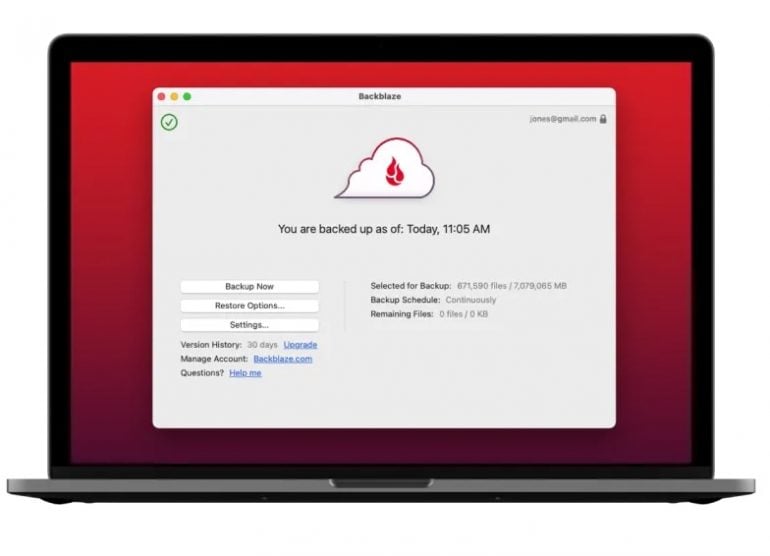
Image: Backblaze
Backblaze is a cloud-based backup software solution that provides an automated and secure way to protect your Mac data. Unlike local backups that require an external drive, Backblaze stores your files in the cloud, ensuring that your data is safe even in the event of physical damage, theft, or other disasters.
It’s one of the best backup software options for Mac users because it’s designed to be simple and offers competitive unlimited storage for a flat monthly fee. The affordability and cloud capabilities make it an ideal choice for individuals and small businesses looking for a cost-effective and robust Mac backup strategy.
Pros:
- Provides unlimited cloud storage.
- Supports multi-factor authentication and private encryption keys.
- Runs automatic and continuous backups of all user data, including files, photos, and system configurations, to the cloud.
- Offers offsite backup, protecting data from local disasters.
- Affordable flat monthly or annual pricing.
- Allows access and file restoration from any location.
- Encrypts files before uploading for added security.
- Offers easy restoration options via download or shipping a hard drive with the data.
Cons:
- The initial backup can be time-consuming.
- Requires an ongoing subscription.
- Default file retention is limited to 30 days.
- Single-computer licenses only.
- No File Explorer or Finder integration.
- Lacks folder syncing.
- Need an internet connection to access your data.
Rating: 7.7 out of 10
Pricing: Personal and Business plans start at $99 per year or $9 per month.
3. Carbon Copy Cloner
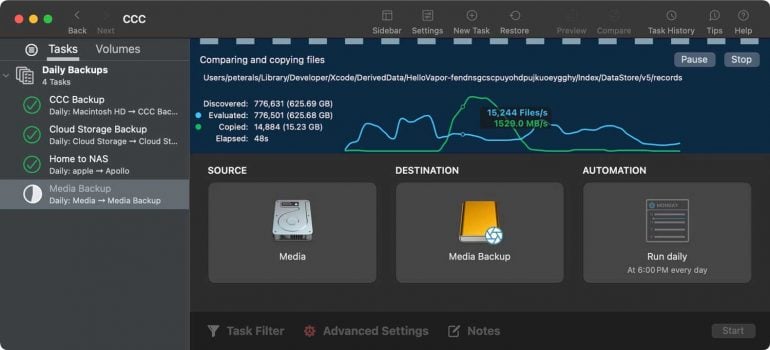
Image: Carbon Copy Cloner
Carbon Copy Cloner (CCC) is a powerful third-party backup software for Mac users, offering advanced features that go beyond what Time Machine provides. Known for its flexibility and reliability, CCC allows users to create bootable backups, schedule backups, and customize their backup process to suit their specific needs.
Unlike basic backup software solutions or iCloud Sync, Carbon Copy Cloner lets you clone your entire hard drive, including the macOS operating system, applications, and settings. In the event of a system failure, you can boot directly from the cloned drive and continue working with minimal downtime.
However, some users have mentioned that it’s not a perfect system, and it’s become increasingly difficult to quickly create and update bootable Mac clones. So while it’s possible to clone all your data, booting from the copy doesn’t always work.
Pros:
- Creates fully bootable backups for fast recovery.
- Offers advanced scheduling options, including hourly, daily, weekly, or monthly backups.
- Uses smart updates to back up only new or changed files to save time and storage space.
- Frequent updates and good customer support.
- Supports backups to external drives, network volumes, and other Macs for added security and flexibility.
- Read-only snapshots are impenetrable to malware and ransomware.
- Comes with three levels of file verification.
- Only need to purchase one license for every Mac in your household.
Cons:
- Requires a one-time purchase, and some might find the price point expensive.
- The wealth of features may be complex for less tech-savvy users.
- No built-in cloud storage option.
- Creating fully bootable clones has become more difficult with newer macOS versions.
Rating: 4.5 out of 5
Price: The personal and family license is a one-time payment of $49.99, and a corporate license is $49.99 per unit for 1 to 4 users.
4. SuperDuper!
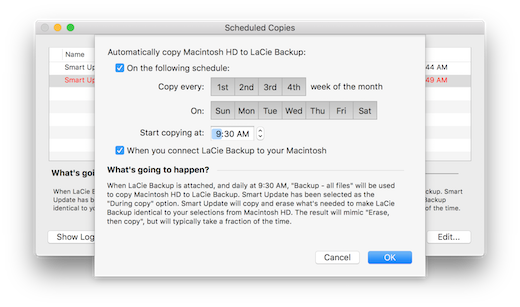
Image: SuperDuper!
SuperDuper! is a powerful and easy-to-use backup software for Mac. It’s known for its ability to create exact, bootable copies of your Mac’s hard drive, ensuring that you can continue working even if your primary drive fails.
While it’s often compared to Carbon Copy Cloner, SuperDuper! stands out with its simplicity, focus on cloning, and affordability. The free version gives you all the basic cloning functionality, but if you need more advanced features like scheduled backups or incremental “smart” updates, you can upgrade to the paid version.
These features make SuperDuper! the better option if you need a straightforward and versatile Mac backup software that gets the job done without overwhelming options.
Pros:
- Creates bootable clones for fast system recovery.
- Simple and easy to use, even for beginners.
- Free version offers full cloning capabilities.
- Smart updates save time by backing up only changed files on the paid version.
- Scheduled backups to automate the process.
- Reliable for restoring macOS, applications, and settings.
- A good companion to Time Machine.
- The once-off licensing fee is affordable and gives you access to all future updates.
Cons:
- No cloud backup option, which means you’re limited to local storage.
- The free version requires you to initiate backups manually.
- Lacks the same flexibility found in other backup apps for Mac users like CCC.
- Only capable of making clones and unable to perform network copies.
Rating: 4.5 out of 5
Price: The once-off licensing fee is $32.79.
5. Arq
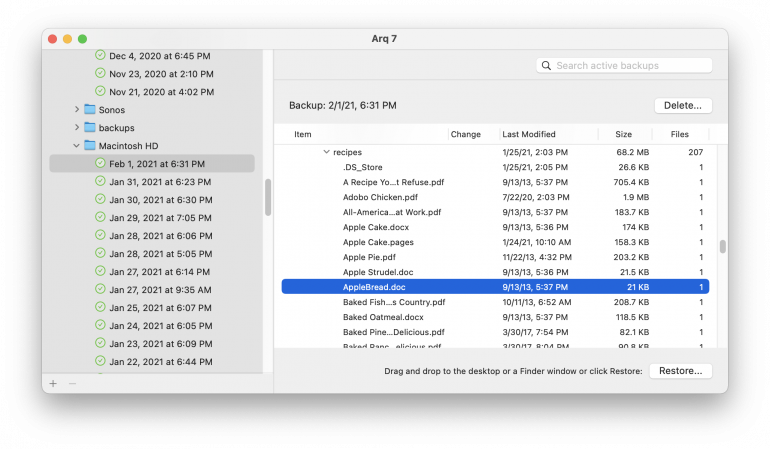
Image: Arq
Arq is a versatile and highly secure cloud-based backup solution for Mac users. Unlike some backup tools that lock you into their own storage, Arq allows you to choose where to store your backups by supporting multiple cloud storage providers like Amazon S3, Google Drive, Dropbox, OneDrive, and more.
Additionally, you can use your own NAS (Network Attached Storage) or external hard drive if you prefer local storage, and all your files are encrypted before leaving your Mac. The combination of flexibility and data security makes Arq one of the best backup software options for Mac, whether you’re a casual or professional user.
Pros:
- Allows backups to multiple cloud providers like Amazon S3 and Google Drive.
- Strong AES-256 encryption with a user-defined password.
- Performs incremental backups to save time and storage space.
- Keeps versioned backups to recover previous file versions.
- Supports both cloud and local storage options, including NAS and external drives.
- One-time purchase for the software.
- Premium plan includes 1TB of cloud storage.
Cons:
- Does not include built-in cloud storage like Backblaze, meaning you’ll need to provide a cloud storage account at an additional cost unless you subscribe to the Premium version.
- The Premium Plan charges for additional TBs of storage.
- Web access to backups is only available on the Premium plan.
- The backups can be slow depending on your data size and internet speed.
Rating: 3.8 out of 5
Pricing: There is a 30-day free trial with paid plans starting at $49.99 per computer or $59.99 per year for the Premium version, which includes 5 computers and 1 TB included storage.
6. Get Backup Pro
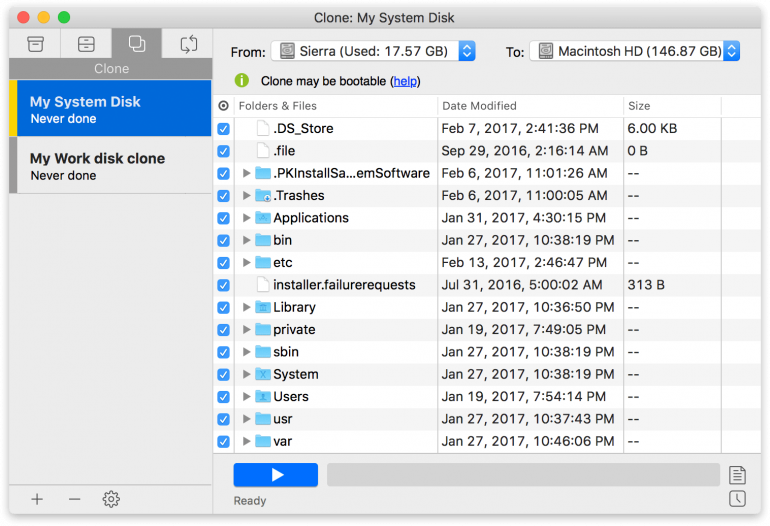
Image: Get Backup Pro
Get Backup Pro is one of the most feature-rich backup apps for Mac. Unlike more basic solutions, it comes with a range of options, including full, incremental, and versioned backups, which give you the ability to tailor your strategy to your specific needs.
Another standout feature of Get Backup Pro is its capability to create bootable clones of your Mac, allowing for quick system recovery in the event of hard drive failure.
It also supports encrypted backups and allows users to back up to network storage locations or even compress and archive backups for more efficient storage management.
With so much flexibility and a range of features, Get Backup Pro is a good option if you want control over data while maintaining ease of use.
Pros:
- Supports full, incremental, and versioned backups.
- Creates bootable clones for fast system recovery.
- Offers encrypted backups using AES-128, AES-256, Blowfish, or Triple DES.
- Allows scheduled backups for automatic data protection.
- Allows users to set up different backup plans for different needs.
- Synchronize files and folders on your Mac.
- Automate your scheduled backup, archive, clone, and sync projects.
- Provides backup compression to save storage space.
- A solid companion option for Time Machine.
- Once-off affordable licensing cost.
Cons:
- No built-in cloud storage integration.
- Advanced features may have a learning curve for beginners.
- Requires a paid license for full functionality.
- No free option.
Rating: 4.9 out of 5
Pricing: 15-day free trial available with paid plans starting at $29.99.
7. ChronoSync
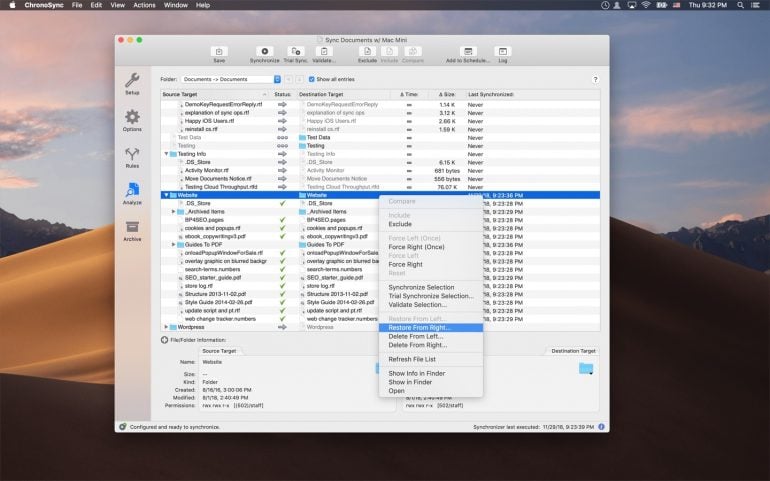
Image: ChronoSync
ChronoSync bills itself as the best backup software and file sync app for Mac users. The software comes with a wide range of features for data protection, file synchronization, and bootable backups.
Unlike other backup software for Mac, ChronoSync lets you set up customized backup plans to sync data between multiple devices, including external hard drives, network volumes, and even remote cloud storage providers. With the option to integrate with ChronoSync’s companion app, ChronoAgent, users can back up and sync data to remote locations, adding another layer of security for data protection.
It’s an ideal choice for users who need advanced control over their backup and synchronization processes, making it especially useful for professionals, small businesses, and power users.
Pros:
- Offers comprehensive and flexible backup and sync functionality.
- Creates bootable backups for fast system recovery.
- Allows syncing between multiple devices and locations.
- Supports incremental backups to save time and space.
- Provides flexible scheduling for automatic backups and syncs.
- Offers detailed logs and reporting for monitoring backup status and troubleshooting issues.
- Highly customizable for specific backup and sync preferences.
- Offers an app (ChronoAgent) for remote backups and syncing.
- Once-off purchase with updates included for life.
Cons:
- No built-in cloud storage option.
- Requires a paid license.
- Initial setup can be time-consuming.
- Lacks intuitive functionality e.g. you can’t see a hierarchical list of an entire volume or check/uncheck the items you want to sync or backup.
- No view to see all your files as they looked at some time in the past.
- A companion program (ChronoAgent) will be needed to maintain ownership and permissions when copying files over a network.
Rating: 4.5 out of 5
Pricing: Free 15-day trial and lifetime subscription of $49.99 per Mac. The companion app, ChronoAgent, is a once-off fee of $19.99.
Choosing the Best Backup Software for You

Image: Christopher Gower
When it comes to answering the question “How to backup your MacBook?” it’s essential to assess your needs to understand whether a simple backup solution like Time Machine or a more robust strategy combining multiple methods will be the best fit for you.
What Do You Need From a Mac Backup App?
Start by evaluating the importance of the data you’re storing. A more comprehensive backup solution is necessary if you’re a professional handling sensitive or critical data. On the other hand, personal files that aren’t frequently updated may not require the same level of redundancy.
You should also consider your technical comfort level. Some backup solutions, like Time Machine, are beginner-friendly, while others, like ChronoSync, offer advanced features that may appeal to tech-savvy users.
Budget is another key factor. There are free and paid solutions on the market, with some backup tools offering additional features for a cost. Understanding your budget and the features you need will help you decide whether the premium version of a backup app for Mac is worth the price.
Consider Combining The Best Backup Software Options
For the best protection, use both local and cloud-based backups. Local backups, like Time Machine or Carbon Copy Cloner, provide quick recovery for issues like accidental deletions or hardware failures. However, external hard drives are vulnerable to physical damage.
Cloud backups (e.g., Backblaze or Arq) protect against fire, theft, and natural disasters but may be slower to restore.
A dual approach ensures convenience, with fast local access and remote availability through the cloud. It also helps you balance cost and storage management while meeting compliance requirements and giving you complete peace of mind.
Use The 3-2-1 Backup Strategy
The 3-2-1 Backup Strategy is a widely recommended method to the question “how to backup your MacBook”. It involves keeping three copies of your data: the original and two backups. This ensures that you can restore your Mac from the other if one copy fails.
These backups should be stored on two different types of media, such as an external hard drive and cloud storage, or an external drive and a NAS (Network-Attached Storage). Using different media types reduces the risk of failure from a single device or technology.
Finally, at least one copy of your backup should be stored offsite. This could be cloud-based storage or a physical backup kept at another location. Offsite storage protects your data from physical threats like fire, flood, or theft, ensuring you can always recover your files, even in the worst-case scenario.
Regular Testing is a Non-Negotiable
No Mac backup strategy is complete without regular testing. Backups can fail, so it’s essential to periodically check that your backups are functioning correctly and that you can restore your data when needed.
Regular testing ensures that your backup files are up-to-date and not corrupted and confirms that your recovery process works smoothly, reducing any potential downtime in case of a failure.
Tools like Timing can help you stick to a regular backup and testing schedule. By tracking your workflow and data creation, you can identify the best times to perform backups without disrupting your productivity.
Protect Your Data With The Best Mac Backup Software
Knowing how to backup your MacBook and having a solid backup strategy is a “must-have” for all MacBook users, especially professionals handling sensitive or irreplaceable data. Whether due to hardware failure, accidental deletion, or unexpected disasters like theft or fire, reliable backups ensure your data remains secure and accessible. Without a proper strategy, data loss can lead to significant downtime, stress, or even financial loss.
So, what is the best backup app for Mac? There’s no one-size-fits-all solution, using the different backup apps for Mac for local and cloud storage will give you the most comprehensive protection from a wide variety of scenarios. Start protecting your data today by choosing a backup method that works for you.
Don’t forget to protect your most valuable asset—your time. Try Timing’s 30-day free trial to track your workflow automatically and discover time sinks, missed billable hours, and the best time to schedule backups without hindering your productivity.
